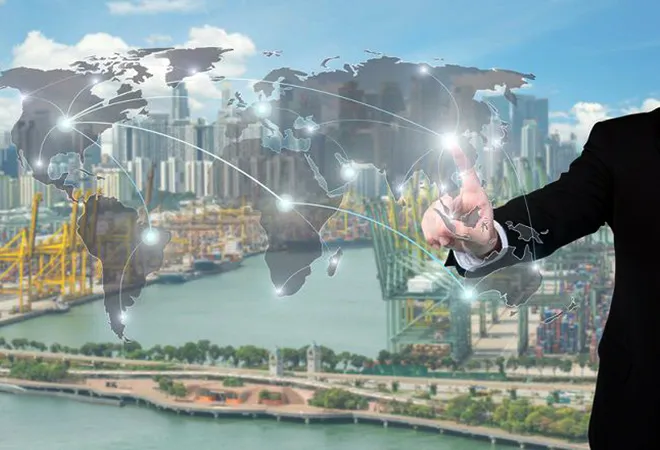
The series of events that has been unfolding on the global trade landscape is making a trade war – triggered primarily by a belligerent US and an aggressive China, as also other global markets – appear imminent. The imminent threat that a global trade war will pose to the world has made this scenario the focus of economic discourse.
The growing contentions between the US and China are keeping the world sweating. Yet, Warren Buffett, the US investor and business magnet, while commenting on the US-China trade conflict, says "I don't think either country will dig themselves into something that precipitates and continues any kind of real trade war… There will be some back and forth, but in the end I don't think we'll come out with a terrible answer on it … benefits are huge and the world's dependent on it in a major way for its progress that two intelligent countries will do something extremely foolish."
The ongoing discourse on the US-China trade conflict will reach fruition only when we understand how free trade, driven by the principle of comparative advantage, can be mutually beneficial for all players, thereby rendering trade war, in Buffett’s words, ‘foolish’.
When free trade is allowed to occur, the trading countries will find incentives in specialising in the production of those commodities in which they enjoy comparative advantage – that is, commodities in the production of which they incur the least opportunity cost vis-à-vis other nations. Lowest opportunity cost implies maximum productivity and cost-efficiency. When nations undertake production and export activity on the basis of their comparative advantage, they choose to operate on the most optimum path of economic growth and scarce resources owned by them get allocated most efficiently. This maximises global output, economic prosperity and welfare. In short, free trade maximises economic gains through efficient allocation of resources.
Yet, economic gains derived from free trade are not realised as easily as economic theory makes it to be. For a nation that discovers its comparative advantage via free trade also discovers its comparative disadvantage. Firms involved in producing commodities, for which the nation has a comparative disadvantage, will have to shut down and displace its workers before they liquidate to release resources for more efficient use. These are costs of adjustment that have to be incurred by certain economic actors before the nation launches itself on its optimum path of economic activity. While in the short-run, adjustment costs will have to be incurred by some stakeholders, increased competitiveness and efficiency will increase the profits of these stakeholders in the long-run. For example, India, post liberalisation, witnessed a difficult transition in its manufacturing sector. Several plants had to shut down and many workers lost their jobs. However, given the economic situation in the post-reform era, India found its comparative advantage in the services sector. India’s exponential post-reform economic growth has been propelled by the services sector, while manufacturing has remained stagnant. Furthermore, according to Paul Krugman, winner of the 2008 Nobel prize for his theory on international trade, India has managed to achieve a strong position in services export in a way that no other large economy has been able to replicate.
Th reality of short-term adjustment costs ushering long-term productivity and profits is not much appreciated. The decision of whether these adjustment costs are to be incurred generally turns political.
The concerned stakeholders are irked by the transition demanded of them. They seek governmental assistance in the form of trade protectionism. What is being witnessed in the US’ tactics against what it considers to be China’s exploitative trade practices, is a classic example. Such action gives refuge to inefficiency which deprives the nation from reaching its potential.
Imposition of trade barriers culminates into higher prices for domestic production as well as imports, depressing global demand and reducing aggregate output. A trade war entails reduced standard of living for consumers and damage to the competitiveness and profitability of businesses. The interdependence between nations in an increasingly globalised world means that these adverse consequences will hit us all and negatively impact global economic prospects.
Advocacy of free trade assumes that the political values underpinning the principle of comparative advantage are peace and co-operation. The source of the US-China trade tension is the alleged violation of this principle by China in a way that threatens peace and co-operation.
The United States alleges that China’s industrial policy involves a forced transfer of technology from US companies who wish to set up production and sell in China. The United States perceives this as a gross violation of US intellectual property rights by China. Even so, a trade war is prohibitively costly and unwise. Rather, the principle of comparative advantage is a powerful, yet peaceful weapon in the hands of the US to tackle this situation.
In another alleged violation of the comparative advantage principle, China has heavily subsidised its domestic steel and aluminum manufacturers, who lack competitiveness, so as to undercut foreign competition in export markets. This subsidisation has resulted in overcapacity, with Chinese metals being dumped into the world market at unrealistically low prices. Production of metals has become a loss-making venture for the US and other companies which actually have a natural comparative advantage in such production. Economic losses incurred due to this alleged violation are alarming: resources lost in subsidisation could have been invested in the economy’s productive capacity; resources engaged in metals production could have been employed in more profitable ventures; the US and other economies could have produced what they are efficient at rather than being forced to misallocate their resources.
However, with some intelligent manoeuvring, the US could well tide over the situation without an all-out trade confrontation with China. With the advent of the fourth Industrial Revolution, the US can reverse the offshoring of manufacturing to China. The US is the global champion in software development, technology and innovation, and can boast about its premier universities. These strengths empower the US to redefine comparative advantage in manufacturing.
Today, innovation is transforming every activity in the manufacturing value chain. Software has emerged as the principal factor of production, powering production systems and processes, and product design and development. Computers, robots and other such technological marvels are the new tools of manufacturing. Sophisticated visualisation and simulation techniques are underpinning successful virtual-to-real manufacturing. Innovation in manufacturing is also being driven by the objective of energy efficiency. These trends are translating into phenomenal gains in productivity and efficiency. Technological progress has also made customisation profitable, allowing tech-proficient nations like the US to increase market access by catering to niche demands. In an increasingly digitised world, innovation can move beyond manufacturing to improve administrative and operational efficiency, reduce logistic costs etc.
The US must invest in its competitive edge as an innovation economy to accelerate the forces driving innovation and strengthen the institutions supporting it. A self-sufficient manufacturing ecosystem must be created to eliminate the need for offshoring.
The government must incentivise these companies to invest in education in a way that makes offshoring less attractive. Eliminating the need to offshore manufacturing to China will enable the US to better protect its intellectual property. Moreover, these measures can enable the US to narrow its yawning trade deficits not only with China, but other nations as well.
There are varied sources of comparative advantage. Sources such as relative abundance of natural resources, climate, geography, size of a nation are gifts of providence. Yet, there are many others that can be augmented by human intervention giving nations the opportunity to improve and maximise gains from free trade: (i) Good infrastructure boosts productivity and minimises cost (ii) Intellectual property protection incentivises invention and innovation (iii) investor protection stimulates investment (iv) efficient and speedy dispute settlement mechanisms reduce losses following disputes (v) absence of nepotism, red tape and corruption implies low costs of establishment and operation for businesses (vi) ease of starting a business (vii) efficient tax regime lowers compliance costs (viii) intense local competition raises competitiveness (ix) the ability to attract and retain talent (x) efficient labour markets being regulated by labour laws that protect stakeholders without harming growth (xi) easily accessible and affordable financial services, particularly credit (xii) strong and appropriately regulated financial market.
Realising gains from free trade depends crucially on how able stakeholders are for making the transition from being comparatively disadvantageous to comparatively advantageous. The above-mentioned sources of comparative advantage lower the adjustment costs associated with such transition and help not just the US, but also countries like India, which are at the wrong end of their balance of payments particularly in their bilateral trade with China. A large part of the burden of this transition is borne by the displaced workforce that is compelled to migrate to a new occupation. Generally, the workforce is skilled in a way that ensures specialisation in a certain occupation which impedes occupational mobility. There is a need to visualise our educational and skill training systems to well-equip the labour force to be robust not only in the face of trade shocks, but also in economic downturn and other sources of change. Our education must enable us to re-skill and up-skill conveniently as demanded by the change being confronted.
Finally, adhering to the principle of comparative advantage requires willingness to adapt. Moreover, sources of comparative advantage are ever-changing requiring that economies reinvent themselves in the light of this change. Nevertheless, the economic gains that follow from obeying this principle are so phenomenal that nations must seek to keep themselves invested in this process.
The views expressed above belong to the author(s). ORF research and analyses now available on Telegram! Click here to access our curated content — blogs, longforms and interviews.




 PREV
PREV


